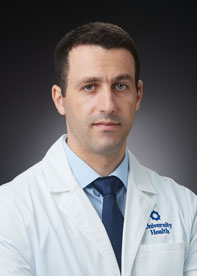The esophagus connects the mouth to the stomach and is the major entry point for all food in the body. It contains an upper and lower sphincter, which act as valves to keep digestion moving in the right direction.
We also treat people who have trouble swallowing (achalasia) and gastroesophageal reflux disease, the backing up of stomach acid into your esophagus.
Conditions We Treat
Achalasia
Achalasia is an uncommon chronic disease, meaning failure to relax. This disease causes difficulty swallowing due to failure of the lower esophageal sphincter muscle to relax properly.
Our team typically uses an esophageal manometry test, which measures muscle contractions, to diagnose achalasia. Once diagnosed, we perform a per oral endoscopic myotomy (POEM) procedure–a long-lasting, highly effective treatment.
Barrett’s Esophagus
Barrett’s is a specific condition that involves a change in the cells of the esophagus which may increase the risk for cancer and is typically caused by chronic acid reflux. Thanks to state-of-the-art technology, we can now evaluate and treat Barrett’s in its early stages using a minimally invasive approach to help reduce your risk of cancer and hasten your recovery.
Cancer, Polyps and Lesions of the Esophagus
Conditions like these can be hard to swallow – literally. Our team of experts have been early adopters of the latest advances in ultrasound and ultra-high-definition cameras that provide you with diagnostic and treatment accuracy unparalleled in South Texas.
Esophageal Motility Disorders
One of the most common reasons for difficulty swallowing includes having an esophageal motility disorder. This condition occurs when the esophageal muscles are not working correctly to allow food to pass naturally to the stomach.
A variety of motility disorders exist, which can be treated with medications or with endoscopic minimally invasive treatments.
Zenker’s Diverticulum
Zenker’s diverticulum is a rare condition that causes severe difficulty swallowing and even recurring aspiration, caused by an abnormally enlarged muscle at the upper esophageal sphincter.
Using our experience from the POEM procedure for achalasia, a similar technique called Z-POEM is used to cut the dysfunctional muscle fibers. This technique allows food to pass down the esophagus naturally and is less invasive and more effective than the classical surgical treatments for Zenker’s diverticulum.



